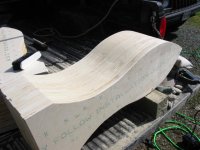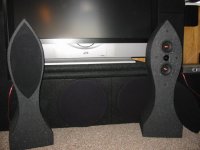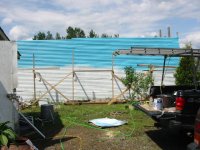Hi All
Does anyone use a technique detailed in this build to create a curved speaker enclosure shape (I'm referring to the 'egg')? Humble Homemade Hifi
I want to investigate this further... anyone know of any interesting threads to read on the subject? I have searched but don't really know what I'm searching for!
Cheers
Chris
Does anyone use a technique detailed in this build to create a curved speaker enclosure shape (I'm referring to the 'egg')? Humble Homemade Hifi
I want to investigate this further... anyone know of any interesting threads to read on the subject? I have searched but don't really know what I'm searching for!
Cheers
Chris
While I have not seen it used in plywood speaker enclosure construction. I have seen the W.E.S.T. (Wet Epoxy Saturation Technique) used to make complex curved plywood items in several other areas.
How to / Publications
How to / Publications
A vacuum bag around the shape may help in clamping the sheets together and reducing the air content of the glued interface.
Even half an atmosphere of suction will be a big improvement, but try for 90% atmosphere of suction.
Even half an atmosphere of suction will be a big improvement, but try for 90% atmosphere of suction.
For glueing up in this sort of situation (stacked pieces) , a press is what is called for... One might use a hydraulic jack working UP against something like the main beam of your house, for example, or an automobile press (a steel frame with a 20 ton hydraulic jack)... your choice of glue is important too, but not so critical imo.
Or just a lot of bar clamps will do the trick too... yep I'd probably use my bar clamps and some stiff flat bits for spreading the top and bottom pressure...
I'd be glueing it up in steps, not all at once...
That is, if I felt the need to do a project like this...
_-_-bear
Or just a lot of bar clamps will do the trick too... yep I'd probably use my bar clamps and some stiff flat bits for spreading the top and bottom pressure...
I'd be glueing it up in steps, not all at once...
That is, if I felt the need to do a project like this...
_-_-bear
You could,
a) CNC out the rings, you could even do it in dovetail sections, so in stead of having 15 rings on a board, you would have 60-70 smaller pieces that could slot perfectly together.
b) In my opinion, it would be way way easier to find something pre-made thats suitable (aka my ikea salad bowl speakers) You must be able to find some beautiful chopping boards, or fruit bowls, wire mesh or i have even heard of balloons being inflated and covered in resin or other strong compounds.
I guess you need to know whether you desire the shape, inside &/or out, the material concentric layers of ply looks pretty special, or both. Without the aid of a CNC machine, it will be a long process.
a) CNC out the rings, you could even do it in dovetail sections, so in stead of having 15 rings on a board, you would have 60-70 smaller pieces that could slot perfectly together.
b) In my opinion, it would be way way easier to find something pre-made thats suitable (aka my ikea salad bowl speakers) You must be able to find some beautiful chopping boards, or fruit bowls, wire mesh or i have even heard of balloons being inflated and covered in resin or other strong compounds.
I guess you need to know whether you desire the shape, inside &/or out, the material concentric layers of ply looks pretty special, or both. Without the aid of a CNC machine, it will be a long process.
One of the terms you want to search on is Translam. This technique is becoming fairly popular because it is a relatively easy (but wasteful -- Cal did find a creative & useful way to use his scrap) way of creating complex shapes. Plywood is a good idea, i've seen far too many of the MDF ones slpit right in the middle of a piece of the MDF.
dave
dave
Thanks Guys. Cal - I did see your thread; it was a good read.
Any advantages to doing it the "Translam" way? I was going to use a router on the inside of the walls so not to create a uniform wall for internal reflections.
It is pretty wasteful but is there anything good (better) than a traditional box build aside from being able to create shapes more easily?
Any advantages to doing it the "Translam" way? I was going to use a router on the inside of the walls so not to create a uniform wall for internal reflections.
It is pretty wasteful but is there anything good (better) than a traditional box build aside from being able to create shapes more easily?
Plywood = good 🙂
MDF = bad 🙁
Dave's right I had some fun with the cut-out scraps. The woman I was with at the time had a big ole ugly metal wall at the back of her property so we painted it blue then re-sawed the cutouts, give'm a little colour and voila!
EDIT: Slow in typing, glad you saw the thread.
MDF = bad 🙁
Dave's right I had some fun with the cut-out scraps. The woman I was with at the time had a big ole ugly metal wall at the back of her property so we painted it blue then re-sawed the cutouts, give'm a little colour and voila!
EDIT: Slow in typing, glad you saw the thread.
Attachments
- Status
- Not open for further replies.
- Home
- Design & Build
- Construction Tips
- Stacking multiple laminations of plywood to create speaker enclosure



